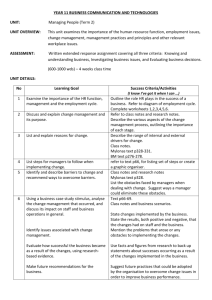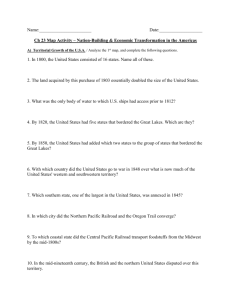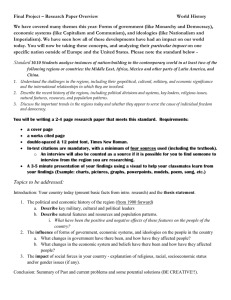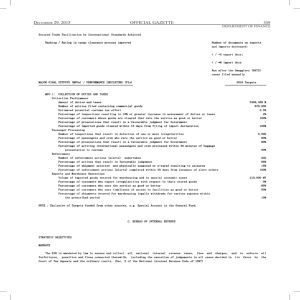The politics of nation-building: making of co- nationals, refugees, and minorities
advertisement
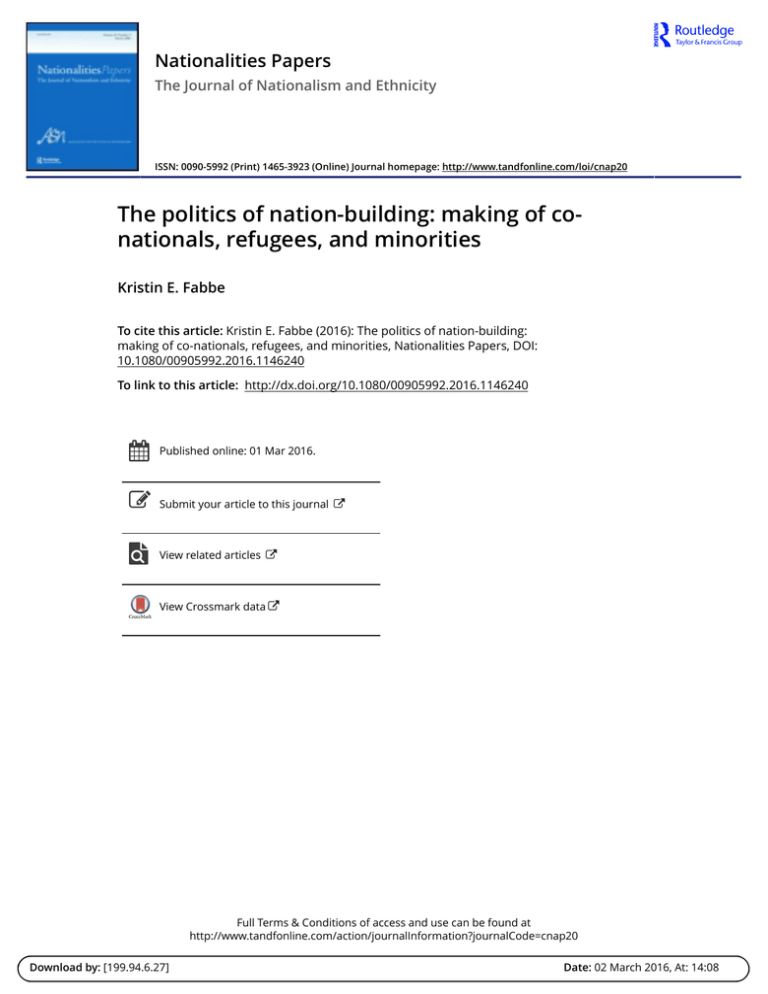
Nationalities Papers The Journal of Nationalism and Ethnicity ISSN: 0090-5992 (Print) 1465-3923 (Online) Journal homepage: http://www.tandfonline.com/loi/cnap20 The politics of nation-building: making of conationals, refugees, and minorities Kristin E. Fabbe To cite this article: Kristin E. Fabbe (2016): The politics of nation-building: making of co-nationals, refugees, and minorities, Nationalities Papers, DOI: 10.1080/00905992.2016.1146240 To link to this article: http://dx.doi.org/10.1080/00905992.2016.1146240 Published online: 01 Mar 2016. Submit your article to this journal View related articles View Crossmark data Full Terms & Conditions of access and use can be found at http://www.tandfonline.com/action/journalInformation?journalCode=cnap20 Download by: [199.94.6.27] Date: 02 March 2016, At: 14:08 Nationalities Papers, 2016 BOOK REVIEW Downloaded by [199.94.6.27] at 14:08 02 March 2016 The politics of nation-building: making of co-nationals, refugees, and minorities, by Harris Mylonas, New York, Cambridge University Press, 2013, 280 pp., $29.99 (paperback) and $89.99 (cloth), ISBN 9781107020450 In The Politics of Nation-Building, Harris Mylonas explores the various policies that the emerging states in the Balkans used to manage diversity and attain order. To be sure, establishing boundaries for legitimate membership in the state – and, by the same token, defining enemies and minorities – was one of the most pressing issues for state elites during the late nineteenth and early twentieth centuries. These new states typically included substantial minority enclaves and had large swaths of territory with ethnically, linguistically, and religiously mixed populations. What is more, ethnic, linguistic, and religious cleavages were often crosscutting as opposed to reinforcing, and boundaries were still in flux. Although Balkan states shared centuries of Ottoman rule and had similar modernization trajectories, state policies toward non-core groups ranged from ethnic cleansing to formal accommodation. Nation-building policies also varied cross nationally and over time. The Politics of Nation-Building engages these interlocking historical puzzles with an impressive combination of theoretical rigor and descriptive richness. Rather than focusing myopically on only the relationship between host-states and noncore groups, Mylonas reorients our attention to the complex regional and international context in which state consolidation takes place. He argues that nation-building policies are largely determined by two factors: (1) patterns of strategic interaction between the host-state and (often meddlesome) external powers and (2) the wider international ambitions of a given host-state. Even while zooming-out to capture the dynamics of the larger international arena, the book’s argumentation remains elegant and parsimonious, laying out a crisp set of theoretical predictions. States will typically accommodate non-core groups that are supported by allied powers. When non-core groups are supported by an enemy power, however, state policies take a different form, which in turn depends on whether the host-state has status quo or revisionist political aims. Overt or covert support for a non-core group by an enemy power produces assimilationist policies toward that group in status quo states and exclusionary policies toward that group in revisionist states. Although Mylonas is not the first to explore how international factors shape minority policies, his approach is unique in that it does not rely ex ante on the idea of territory ethnic kinship and/or the existence of politically salient differences between groups. Rather than assuming that certain differences matter, one of the most sizable contributions of The Politics of Nation-Building is the way in which the book links the macro-level international environment to other micro-level processes that then drive the mobilization and politicization of some group identities and the fusing and merging of others. Toward this end, one of the book’s central claims is that the inclusion versus exclusion dichotomy typically used to describe a state’s relationship with non-core groups tends to obscure more than it illuminates. Mylonas’ archival research vividly demonstrates that state policy rarely comes in a binary, either/or form. States often pursue mixed policies that blend inclusionary and exclusionary elements toward non-core groups as they seek to establish order. What is Downloaded by [199.94.6.27] at 14:08 02 March 2016 2 Book Review more, the inclusion versus exclusion binary suggests a sense of permanence to state policy that is rarely born out in reality. States can and do shift their approach to non-core groups over time, moving between inclusionary and exclusionary objectives as circumstances change. For all of these reasons, Mylonas’ conceptual move to assess nation-building policies in terms of a three-part categorical variable – assimilation, accommodation, and exclusion – is a welcome addition that indeed better captures the range of observed variation in state policy. This framework also enables Mylonas to sidestep some obviously misleading normative connotations (inclusion = good, exclusion = bad). As the book’s empirical chapters make clear, policies of assimilation and accommodation were rarely born out of a warm and fuzzy concern for tolerance and/or a genuine respect for multi-culturalism as the term “inclusion” might somehow suggest. The motivation to adopt policies of assimilation and accommodation was also firmly rooted in structural conditions of fierce international competition for territory, influence, and resources. State elites did not hesitate to pursue the assimilation and accommodation of non-core groups via tactics that were coercive and/or discriminatory if security and geostrategic concerns so demanded. This question of tactics and means is an interesting one, and it cannot be entirely resolved through The Politics of Nation-Building’s theoretical architecture as I understood it. Although Mylonas’ argument about external involvement can predict which policy goal – assimilation, accommodation, or exclusion – a state will aspire to with an impressive degree of accuracy, crucial questions remain when we begin to examine the actual means that policy-makers use to achieve their preferred end. Assimilationist policies can take violent and nonviolent forms; and even within the realm of blatantly coercive, exclusionary policies the various means used to achieve this outcome/goal (segregation, deportation and forced migration, mass killing) leave a number of theoretical and normative questions hanging in the balance. Forced migration and ethnic cleansing are both exclusionary, but are they analytically (and morally) equivalent? Furthermore, some tactics are common across nation-building policies and this can be confusing. For example, internal displacement is used as means for achieving both assimilation and exclusion in the book’s framework. How is it that the same tactic can be central to such divergent policy aims? To Mylonas’ credit, given the complexity and scope of the cases studied in the book, such ambiguities are perhaps inevitable and attest to the fact that The Politics of NationBuilding is as much a work of history as it is political science. The balance between theory, on the one hand, and attention to historical detail and contingency, on the other, is superb. Not once did I get the sense that the book was obscuring crucial historical facts for the sake of theoretical “fit.” The empirical chapters, rooted in thick descriptive accounts that are derived from an impressive array of sources, also provide a great deal of insight as to where future research should shine a light in order to better understand the exact form that nation-building policies take. Still, I sometimes found myself wanting to see a more in-depth discussion of what shifts in nation-building policy meant in practice. For example, one such instance occurred in my reading of the book’s fascinating discussion of the case of the Muslim Valaades and Koniareoi populations in Western Macedonia (Chapter Six). Although I was convinced (and also surprised) by the shifts in nationbuilding goals toward these groups that Mylonas is able to trace through his excellent analysis of General Governor Ioannis Eliakis’ reports, I had a difficult time visualizing what a very short-stint of assimilationist policy would actually look like on the ground. Although it is admittedly beyond the scope of the chapter’s timeframe, I was also hoping for more on how the Greek–Turkish war of 1919–1922 shifted attitudes towards these Muslim non-core Downloaded by [199.94.6.27] at 14:08 02 March 2016 Nationalities Papers 3 groups and potentially rendered the issue of religion more salient. Put simply, the condensed timeframe of this chapter makes sense from the vantage point of micro-level theory testing, but I wondered if religious differences would still be seen as less significant than security/geostrategic factors if the time period of the analysis was extended by even just a few years. Mylonas is well aware of the fact that the coding timespan of a study can affect its conclusions. In fact, one of the most interesting aspects of the book is the way in which such potential “problems” are used to generate an insightful and transparent discussion about research methodology. Chapter Four is exemplary in this respect, with its treatment of how to conceptualize the difference between transitional versus terminal nation-building strategies as well as cases where policy change is driven by a learning mechanism. This chapter, together with the section on “Methodological Contributions” in the Conclusion, should be required reading for those engaged in research on nation-building or on any other political phenomenon where intentions, policies, implementation, and outcomes risk being conflated. To conclude, I would like to suggest that The Politics of Nation-Building is much more than just a book about state policies. Embedded in the two most detailed empirical chapters – Chapter Six on Greek Nation-Building in Western Macedonia and Chapter Seven on Serbian Nation-Building toward Albanians – is also a novel and illuminating argument about the popular origins of nationalism. Through its focus on the international context of nation-building and the dynamics of external agitation and support for non-core groups, this book is also sure to inspire and inform future research on why some groups turned into awakened nations while others did not. Kristin E. Fabbe Harvard Business School, Soldiers Field, Boston, MA 02163, USA kfabbe@hbs.edu © 2016, Kristin E. Fabbe http://dx.doi.org/10.1080/00905992.2016.1146240
